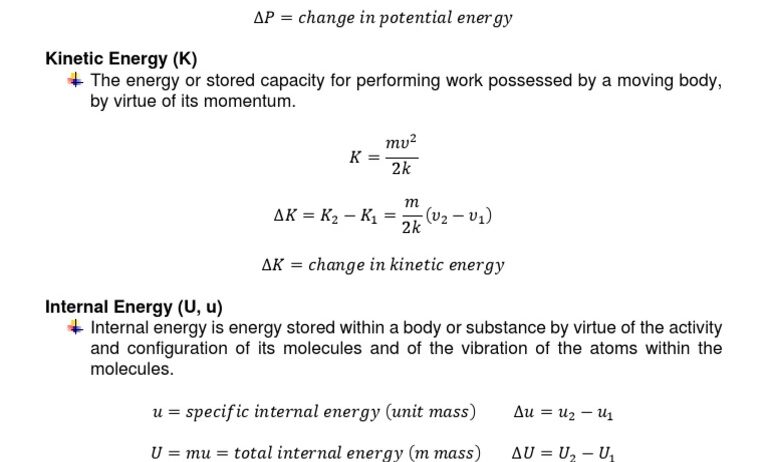Understanding the concept of Delta K within the framework of energy conservation is paramount for both theoretical physics and practical applications in various fields, such as engineering, environmental science, and sustainability. Delta K refers to the change in kinetic energy of a system as it transforms from one state to another. This article delves into the fundamental principles associated with Delta K, its implications in the conservation of energy, and its applications across different scientific domains.
First, it is essential to define kinetic energy. Kinetic energy (KE) is the energy that an object possesses due to its motion, quantified by the equation:
KE = frac{1}{2}mv^2
In this formula, m represents mass, and v signifies velocity. The concept of Delta K can be succinctly expressed as:
ΔK = K_final – K_initial
Where K_final is the kinetic energy of the system at its final state, and K_initial is its kinetic energy at the initial state. This equation facilitates a comprehensive understanding of how an object’s energy changes due to variations in speed or condition.
The principle of conservation of energy posits that energy cannot be created or destroyed; it can only change forms. In practical terms, this means that the total energy in an isolated system remains constant. When analyzing Delta K, it becomes crucial to examine how kinetic energy interacts with other forms of energy, including potential energy. The interplay between these energy types elucidates the underlying mechanisms that govern energy transformations.
Consider a simple scenario: a ball rolled down a hill. At the highest point, the ball possesses significant potential energy (PE), represented by the formula:
PE = mgh
Where h is the height of the ball above a reference point. As the ball descends, the potential energy transitionally converts into kinetic energy, eventually culminating in a maximum speed at the base of the hill. At this moment, the Delta K represents the transformation of energy from potential to kinetic, essentially illustrating one of nature’s pivotal conservation laws.
Moreover, Delta K has significant implications for various energy conservation techniques employed across industries. Renewable energy systems, for example, often utilize principles of kinetic energy transformation. In wind turbines, the kinetic energy from the wind is harnessed and converted into electrical energy, demonstrating a real-world application of Delta K.
A recent analysis in the realm of non-renewable energy sources also highlights the relevance of Delta K. Fossil fuels, for instance, convert stored chemical energy into kinetic energy, which can then power engines. Despite the effectiveness of such conversions, the environmental ramifications arising from such practices necessitate a deeper exploration into sustainable energy alternatives.
When dissecting the nuances of Delta K, it is also pertinent to acknowledge the role friction plays in energy transformation. Friction, a force that opposes motion, mandates energy losses in the form of heat, thereby diminishing the total kinetic energy available for work. In engineering applications, understanding how to minimize frictional forces can lead to more efficient systems that conserve energy more effectively, leading to sustainable outcomes.
Another critical element to consider in Delta K is the size and mass of the object in question. Larger masses require substantial energy input for motion due to their greater inertia. Consequently, the energy transformations—documented via delta K calculations—become increasingly intricate when evaluating systems with multiple moving parts or varying masses. Thus, engineers strive for optimized designs that ensure minimal energy loss, illustrating the practical need for an in-depth comprehension of Delta K.
Furthermore, Delta K serves as an integral factor in the study of dynamic systems, such as vehicles in motion. Transportation engineers calculate Delta K to enhance fuel efficiency, ensuring that the energy expended during transit is maximally utilized. This has broader implications not only for reducing financial costs but also for mitigating greenhouse gas emissions, which play a significant role in climate change.
As society progresses towards more sustainable energy practices, a comprehensive understanding of Delta K becomes essential. In addition to its fundamental definitions and principles, exploring the practical implications of Delta K allows for a multitude of discussions surrounding energy systems, efficiency, and environmental sustainability. Educational initiatives that foster awareness of these concepts can be instrumental in cultivating responsible energy use in future generations.
In conclusion, Delta K encapsulates a fundamental aspect of energy conservation, bridging theoretical concepts with practical applications. By examining kinetic energy changes through the lens of Delta K, one gains insight into the electro-mechanical systems that drive modern technology and the critical need for sustainable practices in an era of environmental awareness. Equipping individuals with knowledge about Delta K catalyzes deeper discussions and actions surrounding the conservation of energy, fostering a more sustainable future.








